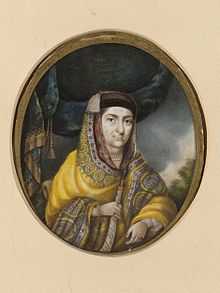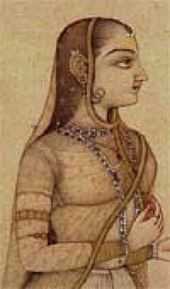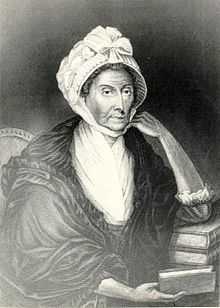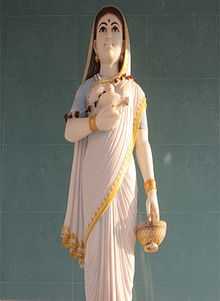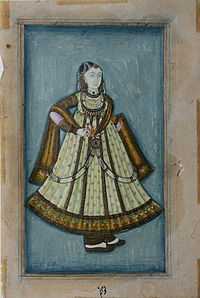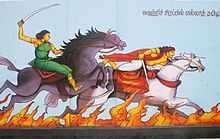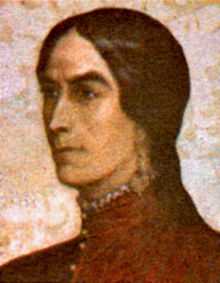Women in 18th-century warfare
| Women in society |
|---|
 |
|
|
|
|
|
|
|
|
|
|
|
|
|
|
|
Active warfare throughout recorded history has predominantly involved male combatants; however, women have also contributed to military activities including as combatants. The following list describes women known to have participated in military actions in the 18th century.
Timeline of women in warfare from 18th century warfare worldwide
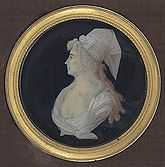
Anne Josephe Theroigne de Mericourt
18th century
- 18th century: Kaipkire of the Herero leads forces against British slave traders.
- 18th century: Ghaliyya al-Wahhabiyya leads military resistance movement to prevent foreign takeover of Mecca.[1]
- 18th century: An unnamed woman serves in the Swedish army in the Great Northern War; after the war, she is seen wearing men's clothing on the streets of Stockholm until the 1740s, where she was known as "The Rider".[2]
- 1700s: Juliana Dias da Costa rides on a war elephant alongside her husband, Mughal emperor of India Bahadur Shah I, in battles to defend his authority.
- 1700s : Mary Read serves as a soldier in Belgium before becoming a pirate.
- 1700s : Margareta von Ascheberg acting colonel of her dead husband's regiment during the Great Northern War.[3]
- 1700 : Charlotte Amalie of Hesse-Cassel organize the defense of Copenhagen against invasion. [4]
- 1700-1709 : Tarabai, a queen of the Maratha empire in India, leads a war against invading Mughals. [5]
- 1700-1712 : Maria Ursula d'Abreu e Lencastro fights in the Portuguese army in India.
- 1702: Anna Isabella Gonzaga, Duchess of Mantua, defends Mantua during the War of the Spanish succession as regent during the absence of her spouse.[6]
- 1702: Marij Jacobs Weijers serve in the Dutch army dressed as a male.[7]
- 1704: Mai Bhago leads Sikh soldiers against the Mughals.
- 1705-1708: Catherina Margaretha Linck serves as a soldier in the armies of Hanover, Prussia, Hesse, and Poland.
- 1705: Grietje Harmense Knipsaar serve in the Dutch army dressed as a male under the name Dirk Jansen.[7]
- 1706: Gertruid ter Brugge seve in the Dutch dragoons and is afterward a local celebrity known as "La Dragonne".[8]
1710s
- 1710s: During the Great Northern War, Maria Faxell, the wife of a vicar, defends her village against a Norwegian attack by handing out old weapons to both men and women during her husband's absence.[9]
- 1711–1721: Ingela Gathenhielm operates the Swedish Privateering fleet jointly with her husband during the Great Northern War; when widowed in 1718, she continues herself.[10]
- 1712-1714: Anna Jöransdotter from Finland serves in the Swedish army under the named Johan Haritu. [11]
- 1712-1717: Three unnamed females are discovered to have served in the Dutch Marines dressed as males.[7]
- 1713-1721: Margareta Elisabeth Roos is said to have served in the Swedish army.[12]
- 1713-1726: Ulrika Eleonora Stålhammar serves in the Swedish army under Charles XII of Sweden during the Great Northern War [13]
- 1713-1714: Annika Svahn, as well as several other enslaved Finnish women taken captive by the Russians, are forced to participate in the Russian conquest of Swedish Finland on the battle fields during the Greater Wrath dressed in Russian dragoon uniforms.[14]
- 1715: Two unnamed women are rumored among the soldiers to serve in the Swedish army, one of them a wife of one of the soldiers, who by this point was to have served for a period of four years.[15]
- 1716: Norwegian Anna Colbjørnsdatter is granted the success in the victory over the Swedes at the Battle of Norderhov in Norway during the Great Northern War 29 March 1716 by capturing 600 Swedish soldiers.[16]
- 1716: Norwegian Kari Hiran averts the Swedish attempt to conquer Norway by feeding them false information about the size of the Norwgian army.[17]
- 1716-1718: Hangbe in the Kingdom of Dahomey becomes the regent after her twin brother Akaba is killed. Oral traditions say that when Akaba died, she put on his armour and acted in his place for the rest of war in the Ouémé River valley.
- 1719: Brita Olsdotter, an old Swedish woman, meets the Russian army, who marches against Linköping after having burnt Norrköping, and makes them turn around and leave after telling them that reinforcements were arriving to assist Linköping.[18]
1720s
- 1720–1739: Granny Nanny, a spiritual leader of the Maroons of Jamaica, leads rebel slaves in First Maroon War against the British.[19]
- 1721: Comtesse de Polignac, preciously the lover of Duc de Richelieu, fight a duel with her rival and successor, the Marchioness de Nesle. [20]
- 1722: Six unnamed females are shipped back to the Netherlands after having been exposed to have served as males in either the Dutch Marines or army in an attempt to emigrate to the Dutch East Indies.[7]
- 1723: Lumke Thoole serve in the Dutch navy dressed as a male under the name Jan Theunisz.[7]
- 1725: Dutch woman Maria ter Meetelen serves in the Spanish army dressed as a man.[21]
- 1726: Maria Elisabeth Meening serve in the Dutch navy dressed as a male.[7]
1730s
- 1732: An unnamed female serve in the Dutch army dressed as a male.[7]
1740s
- 1740: Ann Mills fights on the frigate Maidenstone as a dragoon.
- 1741-1743: Maria van de Gijessen serve in the Dutch navy under then name Claes van de Gijessen.[22]
- 1744: An unnamed female serve in the Dutch navy dressed as a male.[7]
- 1745: Jacobina (last name unknown) serve in the Dutch navy dressed as a male.[7]
- 1745: An unnamed female serve in the Dutch navy dressed as a male.[7]
- 1745: Countess Mary Hay raises an army of Buchan men for Prince Charles Edward Stuart.
- 1745: Lady Anne Farquharson-MacKintosh raises 200–400 men of her clan to fight in the Jacobite rising, but does not lead them.
- 1745: Phoebe Hessel fights in the Battle of Fontenoy. She had disguised herself as a man to do so.[23]
- 1745: Scottish Mary Ralphson fights in the British army in Battle of Fontenoy dressed as a man[24]
- 1746: Johanna Bennius serve in the Dutch navy dressed as a male under the name Jan Drop.[7]
- 1746: Elisabeth Huyser serve in the Dutch army dressed as a male.[7]
- 1746–1769: Maria van Antwerpen serves as a soldier in the Netherlands under the name Jan van Art.[25]
- 1748: Gertruid van Duiren enlists and briefly serve in the Dutch army before being discovered[26]
- 1747-1750: Hannah Snell, serve disguised as a man in the Royal Marine: her military service is officially recognized in 1750, and she is granted a pension.[27]
1750s
- 1750: Maria Sophia Stording serve in the Dutch navy dressed as a man.[28]
- 1751: Two unnamed soldiers of the Dutch navy are discovered to be females dressed as males.[29]
- 1754: An unnamed female serve in the Dutch army dressed as a man.[30]
- 1755: An unnamed female serve in the Dutch navy dressed as a man.[31]
- 1755: Cherokee leader Nancy Ward fights side-by-side with her husband at the Battle of Taliwa. When her husband is killed, she picked up his rifle and led the Cherokee to victory.
- 1756: Soldier Jochem Wiesse of the Dutch army are discovered to be a female dressed as a male.[32]
- 1757: Sailor "Arthur Douglas" is revealed to be a woman. Her birth-name is unknown.[33]
- 1757: An unnamed female serve in the Dutch army dressed as a man.[34]
- 1757-58: Two unnamed females serve in the Dutch navy dressed as a males.[35]
- 1759-1771: Mary Lacy serves as a Marine carpenter under the name of "William Chandler".[36]
1760s
- 1760s: Petronella van den Kerkhof possibly serve in the Dutch army as a grenadier: however, as she was not discovered during service, this is unconfirmed [37]
- 1760s: Hannah Witneg serves in the Royal Marines while disguised as a man from 1756 to 1761. She is noted for serving with "fortitude and valor".
- 1760: Petronella van der Kerkhof serve in the Dutch grenadiers dressed as a male.[38]
- 1760-1761: A woman serves in the British Marines as "William Prothero".[33]
- 1762: Rafaela Herrera inspires the outnumbered Spanish defenders to victory during a 1762 British siege of the Fortress of the Immaculate Conception in El Castillo village within El Castillo municipality, Nicaragua.[39]
- 1763: After the assassination of her husband Diego, Filipina Gabriela Silang decided to continue his rebellion in Ilocos against Spain but was unsuccessful.[40]
- 1764: The Dutch soldier Tiesheld is discovered to be a female dressed as a male.[41]
- 1765: A unnamed member of the Dutch navy is discovered to be a female dressed as a male.[42]
- 1767-1795: Reign of Ahilyabai Holkar, Indian queen of the Malwa kingdom. She personally led troops into battle.
- 1768: Birth of Mah Laqa Bai. Due to her archery skills, she accompanied the Nizam II (Mir Nizam Ali Khan) in three wars;[43]
- 1769: Anna Sophia Spiesen serve in the Dutch army dressed as a male under the name Claas Paulusse.[44]
1770s
- 1770s: Cherokee woman Cuhtahlatah causes her people to rally in battle by attacking the enemy after her husband was killed.
- 1770-1771: Margareta Reymers serve in the Dutch navy dressed as a man: she is discovered by her pregnancy. [45]
- 1772: Mademoiselle de Guignes and Mademoiselle d'Aguillon fight a duel in Paris.[46]
- 1770s: Elizabeth Hutchinson Jackson, the mother of Andrew Jackson, treats and nurses sick and wounded Continental soldiers in American Revolutionary War on British prison ship, dying of cholera as a result.
- 1775: On Dec. 11, Jemima Warner was killed by an enemy bullet during the siege of Quebec. Mrs. Warner had originally accompanied her husband, PVT James Warner of Thompson’s Pennsylvania Rifle Battalion, to Canada because she feared that he would become sick on the campaign trail and she wanted to nurse him. When PVT Warner eventually died in the wilderness en route to Quebec, Mrs. Warner buried him and stayed with the battalion as a cook.[47]
- 1776-1782: During the American Revolution, women served on the battlefield as nurses, water bearers, cooks, launderers and saboteurs.[48]
- November 16, 1776: Margaret Corbin assists her husband in manning the cannons while fighting the British in battle in the American Revolutionary War. When her husband is killed, she mans the cannons alone. She later became the first woman to earn a military pension.[49]
- 1777, April, 26: Sybil Ludington warns colonists that the British were burning the city of Danbury, Connecticut during the American Revolution.
- 1778: Molly Pitcher (born Mary Ludwig in 1754) married John Hays in 1769. Her husband fought for the Continental Army at the Battle of Monmouth (New Jersey) on June 28, 1778. During the battle, she brought pitchers of water to her husband and fellow soldiers, thus earning the appellation Molly Pitcher. When her husband succumbed to exhaustion, she picked up his rifle and fought against the British.
- 1778: Baltazara Chuiza leads a rebellion against the Spanish in Ecuador.[50]
- 1778-1781: Ann Bates serves as a spy for the British loyalists during the American Revolutionary War.
- 1778: Sikh princess Bibi Rajindar Kaur leads 3,000 soldiers to rescue her cousin who was defeated by Hari Singh.
- 1778-1803: The ruling Princess of Sardhana, Begum Samru (Johanna Noblis), leads her armies in war.
1780s
- 1780: Rani Velu Nachiar of Sivagangai Poligar leads a female army against the British in India.[51]
- 1780: Manuela Beltrán organizes a peasant revolt in Colombia.
- 1780: Ñusta Huillac of the Kolla tribe rebels against the Spanish in Chile.
- 1780-1781: Micaela Bastidas Puyucahua recruits and leads men and women in battle during a rebellion against the Spanish rule in Peru. She is eventually captured and executed by the Spanish.[52]
- 1780-1781: Maria van Spanje serve in the Dutch navy for eight months dressed as a male: she is discovered while trying to repeat this when enlisting anew in 1782 [53]
- 1781: Lena Catharina Wasmoet serve in the Dutch navy dressed as a man under the name Claas Waal.[54]
- 1780s: Swedish runaway Carin du Rietz becomes a soldier at the royal guard. [55]
- 1781: Gregoria Apaza, an Aymara woman, leads an uprising against the Spanish in Bolivia.[56]
- 1781: Margaret Thompson serves in the British Marines under the name George Thompson.
- 1781: A female known as "Miss Jenny" serves as a spy for the British during the American Revolutionary War.
- 1781: Kate Barry warns the American militia that the British were approaching before the Battle of Cowpens. Her warning gives the colonists enough time to prepare and win the battle.
- 1782-1783: Deborah Sampson serves in the American army during the American Revolutionary War while disguised as a man. She is the first known American woman to join the military, the first to fight in combat, and the first to receive a military pension.
- 1782: Anna Maria Everts serve in the Dutch navy dressed as a man.[57]
- 1782: Bartolina Sisa, an Aymara woman who led an indigenous uprising against the Spanish in Bolivia, is captured and executed.[58]
- 1783: Johanna Dorothea Heeght serve in the Dutch navy dressed as a man under the name Johannes Hegt.[59]
- 1785: According to Thai legend, Thao Thep Kasattri and Thao Sri Sunthon, two sisters, help repel a Burmese invasion of Thailand by dressing as male soldiers and rallying the troops.
- October 25, 1785: Toypurina, a Tongva medicine woman, rebels against the Spanish, leading an attack against Mission San Gabriel Arcángel.
- 1787-1807: A woman serves twenty years in the British Marines under the name "Tom Bowling"[33]
- 1787 : The wife of the German colonel Schutz is reported to have accompanied her spouse dressed as a male in warfare and having been wounded two times in Russian service. [60]
- 1788-1790 : After the war between Russia and Sweden, several of the soldiers decorated in the Swedish army are discovered to be women in disguise. One of them is Brita Hagberg, who enlisted in search of her husband; she is given a military pension.Kvinnorna och kriget. [61]
- 1788-1790 : During the Russo-Swedish war, Anna Maria Engsten, after a battle at sea, singlehandedly steers one of the boats back to Sweden after having been left alone onboard after its evacuation; she is decorated for bravery at sea.[62]
- 1788-1790 : During the Battle of Svensksund, Dorothea Maria Lösch takes command of a Swedish ship and is rewarded with the rank of captain of the Swedish fleet [63]
- 1789: Female revolutionary Anne Josephe Theroigne de Mericourt leads the storming of the Bastille in Paris at the beginning of the French Revolution. She also leads female troops in 1792-1793.
1790s
- 1792: Reine Audu participates in the fight with the Swiss guards in the storming of the Tuileries Palace.
- 1792: Two hundred and eighty women participate in defense of the city of Frauenbrünn in Switzerland.
- 1792: The Albanian woman Moscho Tzavela leads several women in defense of their village against the Turks.[64]
- 1792: Eight thousand women are estimated to have served openly in the French army in informal local defense troops (though not in the battle fields) between 1792 and 1794. Women were forbidden from joining the army 1795 and the female soldiers are encouraged to "return to their homes".
- 1792: Mary Anne Talbot serves as a drummer boy in the British army for two years.
- 1792: Lady Braddock and Mrs. Elphinstone fight a duel in England. [65]
- 1792-1808: Marie-Jeanne Schellinck serve in French army. She participates in the Battle of Jemappes.[66]
- 1792-1799: Angelique Brulon serves in the French army in Corsica. Although she initially disguises her self as a man, she is eventually allowed to remain openly in her service because of her acknowledged military skill.
- 1793: Suzanne Belair, called Sanité Belair, serve in the armé of Toussaint Louverture during the Haitian Revolution. She was promoted to sergeant, and was executed by the French in 1802. [67]
- 1790s: Victoria Montou serves in the army of Jean-Jacques Dessalines during the Haitian Revolution.
- 1793: Renée Bordereau disguises herself as a man and fights as a Royalist cavalier in the French Revolution. [68]
- 1793: Francoise Deprés serve as a royalist spy, courier and soldier dressed as a male during the Vendée rebellion.[69]
- 1793: Céleste Bulkeley serve in the Catholic and Royal Army during the war in the Vendée as one of at least six women known as the amazons in the army of François de Charette.
- 1793-1800: Therese Figeur serve openly in the French army.[70]
- 1793: An unnamed female serve in the Dutch navy dressed as a man.[71]
- 1796: Sikh princess Bibi Sahib Kaur leads armies into battle against the British. She is the only Indian woman to win battles against a British general.
- 1796-1798: Wang Cong'er is the leader and commander of the White Lotus rebellion in China.
- 1797: Margaret Catchpole serves in the British Marines as a man.
- 1797-1801: Franziska Scanagatta serve in the Austrian army: she is promoted a lieutenant in 1800.[72]
- 1798: Mary Ann Riley and Anne Hopping serve in the British Marines during the Battle of the Nile against the French outside Egypt.[73]
- 1798: Mary Doyle, an Irish woman, participates in the Irish rebellion against the British.[74]
- 1798: Betsy Gray fought in the Battle of Ballynahinch against the Yeomanry.[75]
- 1799: The German Antoinette Berg serve on the side of the English against the French in the Netherlands dressed as a male; during the peace festivities in London after the final defeat of Napoleon in 1814, she was presented to the Tsar of Russia and the King of Prussia.[76]
See also
Further reading
- Cook, Bernard, ed. Women and War: Historical Encyclopedia from Antiquity to the Present (2006).
- Elshtain, Jean Bethke. Women and War (1995)
- Elshtain Jean, and Sheila Tobias, eds. Women, Militarism, and War (1990)
- Mayer, Holly A. Belonging to the Army: Camp Followers and Community during the American Revolution (University of South Carolina Press, 1996)
- Jones, David. Women Warriors: A History (Brassey's, 1997)
- Martino-Trutor, Gina Michelle. "Her Extraordinary Sufferings and Services”: Women and War in New England and New France, 1630-1763" PhD Dissertation, U of Minnesota, 2012. online
- Pennington, Reina. Amazons to Fighter Pilots: A Biographical Dictionary of Military Women (2003).
References
- ↑ "Warriors: Asian women in Asian society". Colorq.org. Retrieved 2008-06-30.
- ↑ 208 (Anteckningar om svenska qvinnor)
- ↑ Margaretha Ascheberg, von, urn:sbl:18867, Svenskt biografiskt lexikon (art av Gunnar Carlquist.), hämtad 2014-12-28.
- ↑ Dansk Biografisk Leksikon
- ↑ Eaton, Richard M. (2005). A Social History of the Deccan, 1300-1761: Eight Indian Lives, Volume 1. Cambridge, England: Cambridge University Press. pp. 177–203. ISBN 0-521-25484-1.
- ↑ Enciclopedia Italiana (1929)
- ↑ 7.0 7.1 7.2 7.3 7.4 7.5 7.6 7.7 7.8 7.9 7.10 7.11 Rudolf Dekker en Lotte van de Pol, Vrouwen in mannenkleren. De geschiedenis van een tegendraadse traditie. Europa 1500-1800 (Amsterdam 1989)
- ↑ Brugge, Geertruid ter (?-na 1706)
- ↑ 134 (Anteckningar om svenska qvinnor)
- ↑ Harrison, Dick (2007). ”Kvinnorna som blev pirater: två kvinnliga sjörövare står fram i vår historia : kaparredaren Ingela Gatenhielm och piratdrottningen Johanna Hård : båda visade att brott kan löna sig!”. Svenska turistföreningens årsbok "2007,": sid. 24-35. 0283-2976.
- ↑ Borgström Eva, ed (2002). Makalösa kvinnor: könsöverskridare i myt och verklighet (Marvelous Women: genderbenders in myth and reality) Stockholm: Alfabeta/Anamma. Libris 8707902. ISBN 91-501-0191-9 (inb.)(Swedish)
- ↑ Borgström Eva, ed (2002). Makalösa kvinnor: könsöverskridare i myt och verklighet (Marvelous Women: genderbenders in myth and reality) Stockholm: Alfabeta/Anamma. Libris 8707902. ISBN 91-501-0191-9 (inb.)
- ↑ Borgström Eva, ed (2002). Makalösa kvinnor: könsöverskridare i myt och verklighet (Marvelous Women: genderbenders in myth and reality) Stockholm: Alfabeta/Anamma. Libris 8707902. ISBN 91-501-0191-9 (inb.)(Swedish)
- ↑ Suomen kansallisbiografia (National Biography of Finland)
- ↑ Borgström Eva, ed (2002). Makalösa kvinnor: könsöverskridare i myt och verklighet (Marvelous Women: genderbenders in myth and reality) Stockholm: Alfabeta/Anamma. Libris 8707902. ISBN 91-501-0191-9 (inb.)(Swedish)
- ↑ Hans Colbjørnsen (Store norske leksikon)
- ↑ Norheim, Olav: «Den modige finnekjærringa», Terra Buskerud. Historieboka.no
- ↑ 291 (Anteckningar om svenska qvinnor)
- ↑ Government of Jamaica, national heroes listing
- ↑ Lewis G. M. Thorpe: Nottingham French Studies, V. 41. W. Heffer., 2002.
- ↑ Digitaal Vrouwenlexicon van Nederland (DVN)
- ↑ Gijssen, Maria van de (1720?-na 1743)
- ↑ The Circulator of useful knowledge, amusement, literature, science and general information. London, 1825 p.147
- ↑ Isabelle Bauino,Jacques Carré,Cécile Révauger: The Invisible Woman: Aspects Of Women's Work In Eighteenth-century Britain. Retrieved 6 October 2014.
- ↑ FTM Contributions in HIStory
- ↑ Duiren, Geertruit van (?-na 1748)
- ↑ Matthew Stephens - Hannah Snell: The Secret Life of a Female Marine, 1723–1792
- ↑ Rudolf Dekker en Lotte van de Pol, Vrouwen in mannenkleren. De geschiedenis van een tegendraadse traditie. Europa 1500-1800 (Amsterdam 1989)
- ↑ Rudolf Dekker en Lotte van de Pol, Vrouwen in mannenkleren. De geschiedenis van een tegendraadse traditie. Europa 1500-1800 (Amsterdam 1989)
- ↑ Rudolf Dekker en Lotte van de Pol, Vrouwen in mannenkleren. De geschiedenis van een tegendraadse traditie. Europa 1500-1800 (Amsterdam 1989)
- ↑ Rudolf Dekker en Lotte van de Pol, Vrouwen in mannenkleren. De geschiedenis van een tegendraadse traditie. Europa 1500-1800 (Amsterdam 1989)
- ↑ Rudolf Dekker en Lotte van de Pol, Vrouwen in mannenkleren. De geschiedenis van een tegendraadse traditie. Europa 1500-1800 (Amsterdam 1989)
- ↑ 33.0 33.1 33.2 Suzanne J. Stark: Female tars: women aboard ship in the age of sail. Naval Institute Press, 1996
- ↑ Rudolf Dekker en Lotte van de Pol, Vrouwen in mannenkleren. De geschiedenis van een tegendraadse traditie. Europa 1500-1800 (Amsterdam 1989)
- ↑ Rudolf Dekker en Lotte van de Pol, Vrouwen in mannenkleren. De geschiedenis van een tegendraadse traditie. Europa 1500-1800 (Amsterdam 1989)
- ↑ "The Lady Tars: The Autobiographies of Hannah Snell, Mary Lacy and Mary Anne Talbot". Retrieved 6 October 2014.
- ↑ Kerkhof, Petronella van de (ca. 1741-1818)
- ↑ Rudolf Dekker en Lotte van de Pol, Vrouwen in mannenkleren. De geschiedenis van een tegendraadse traditie. Europa 1500-1800 (Amsterdam 1989)
- ↑ Carlos Viscasillas (2009). "La Fortaleza de la Inmaculada Concepción de María" (in Spanish). Managua, Nicaragua: Agencia Española de Cooperación Internacional para el Desarrollo (AECID). Retrieved 2011-04-24.
- ↑ Commire, Anne, and Deborah Klezmer. Women in World History: A Biographical Encyclopedia. Waterford, CT: Yorkin Publications, 2002. Print.
- ↑ Rudolf Dekker en Lotte van de Pol, Vrouwen in mannenkleren. De geschiedenis van een tegendraadse traditie. Europa 1500-1800 (Amsterdam 1989)
- ↑ Rudolf Dekker en Lotte van de Pol, Vrouwen in mannenkleren. De geschiedenis van een tegendraadse traditie. Europa 1500-1800 (Amsterdam 1989)
- ↑ Rajendra, Rajani (19 April 2013). "Glimpse into Mah Laqa’s life". The Hindu. Retrieved 23 May 2013.
- ↑ Rudolf Dekker en Lotte van de Pol, Vrouwen in mannenkleren. De geschiedenis van een tegendraadse traditie. Europa 1500-1800 (Amsterdam 1989)
- ↑ Reymers, Margareta (ca. 1747-na 1771)
- ↑ Florence Marryat: Her Father's Name
- ↑ Women In Military Service For America Memorial
- ↑ Women In Military Service For America Memorial
- ↑ Education & Resources - National Women's History Museum - NWHM
- ↑ Uglow, Jennifer; Maggy Hendry (1999). Frances Hinton, ed. The Northeastern Dictionary of Women's Biography. UPNE. p. 75. ISBN 978-1-55553-421-9.
- ↑ The Hindu - 10-Aug-2010
- ↑ Uglow, Jennifer; Maggy Hendry (1999). Frances Hinton, ed. The Northeastern Dictionary of Women's Biography. UPNE. p. 75. ISBN 978-1-55553-421-9.
- ↑ Spanje, Maria van (1759?-na 1782)
- ↑ Rudolf Dekker en Lotte van de Pol, Vrouwen in mannenkleren. De geschiedenis van een tegendraadse traditie. Europa 1500-1800 (Amsterdam 1989)
- ↑ Jakob Christensson: Signums svenska kulturhistoria. Gustavianska tiden. (2007)
- ↑ del Valle de Siles, María Eugenia (1981). Bartolina Sisa y Gregoria Apaza: dos heroínas indígenas. Biblioteca Popular Boliviana de "Última Hora". p. 73.
- ↑ Rudolf Dekker en Lotte van de Pol, Vrouwen in mannenkleren. De geschiedenis van een tegendraadse traditie. Europa 1500-1800 (Amsterdam 1989)
- ↑ Hylton, Forrest (2007). Revolutionary horizons: Popular struggle in Bolivia. London: Verso. ISBN 978-1-84467-070-3.
- ↑ Rudolf Dekker en Lotte van de Pol, Vrouwen in mannenkleren. De geschiedenis van een tegendraadse traditie. Europa 1500-1800 (Amsterdam 1989)
- ↑ Potemkin: Catherine the Great's Imperial Partner, 2005 (Swedish edition), p 445
- ↑ Christer Johansson: Soldathustrur, markenteskor och kvinnliga krigare
- ↑ 130 (Anteckningar om svenska qvinnor)
- ↑ 250 (Anteckningar om svenska qvinnor)
- ↑ Dever, John P.; Dever, Maria C. (1995). "Moscho Tzavella". Women and the Military: Over 100 Notable Contributors, Historic to Contemporary. Jefferson, N.C.: McFarland & Co. p. 142. ISBN 978-0-89950-976-1.
- ↑ Robert Baldick: The Duel: A History of Duelling
- ↑ Les militaires qui ont changés la France, sous la direction de Fabrice Fanet et Jean-Christophe Romer ; avec la collaboration de Thierry Widemann. Paris, le Cherche-Midi, DL 2008 (p. 472) (notice BnF no FRBNF41279187r)
- ↑ Jomini, Antoine-Henri. (1842). Histoire critique et militaire des guerres de la Révolution
- ↑ Marilyn Yalom, Blood Sisters: The French Revolution in Women's Memory, Basic Books, 1993, p. 201.
- ↑ Rudolf Dekker en Lotte van de Pol, Vrouwen in mannenkleren. De geschiedenis van een tegendraadse traditie. Europa 1500-1800 (Amsterdam 1989)
- ↑ Gabriel Dumay, Thérèse Figueur, dite Madame Sans-Gêne, dragon aux 15e et 93 régiments (1793-1815) (1904), with subsequent additions in "Extrait des procès-verbaux du séances", Mémoires de l'Académie des Sciences, Arts et Belles-Lettres de Dijon, 4th Series, vol. 11 (1910), pp. xxxii-xxxiv, lviii-lx; Léon Hennet, "Femmes Soldats dans les armees de la révolution", La Nouvelle Revue Francais 40 (1919), pp. 341-353 at pp. 347–48; Philippe Lefrancois, "La vraie Madame Sans-Gêne, dragon et blanchisseuse", Miroir de l'histoire 98 (1958), pp. 233–236.
- ↑ Rudolf Dekker en Lotte van de Pol, Vrouwen in mannenkleren. De geschiedenis van een tegendraadse traditie. Europa 1500-1800 (Amsterdam 1989)
- ↑ Nikolaus Reisinger: Frauen und Militär in der Neuzeit: Francesca Scanagatta - Die militärische Karriere einer Frau im ausgehenden 18. Jahrhundert. In: Das achtzehnte Jahrhundert und Österreich. (= Jahrbuch der Österr. Gesellschaft zur Erforschung des 18. Jahrhunderts. 16/2001). Wien 2001, S. 59–73.
- ↑ Beth Hill,Cathy Converse: The Remarkable World of Frances Barkley: 1769-1845
- ↑ "Women and War: A Historical Encyclopedia from Antiquity to the Present. Bernard A. Cook". Retrieved 6 October 2014.
- ↑ Bartlett/Dawson/Keough: Thomas Bartlett, Kevin Dawson, Daire Keogh, The 1798 Rebellion: An Illustrated History, Roberts Rinehart, 1998, p.172
- ↑ Rudolf Dekker en Lotte van de Pol, Vrouwen in mannenkleren. De geschiedenis van een tegendraadse traditie. Europa 1500-1800 (Amsterdam 1989)
External links
|
|---|
| | Sovereign states | |
|---|
| | |
|---|
| |
- Canary Islands / Ceuta / Melilla / Plazas de soberanía (Spain)
- Madeira (Portugal)
- Mayotte / Réunion (France)
- Saint Helena / Ascension Island / Tristan da Cunha (United Kingdom)
|
|---|
|
Women in North America |
|---|
| | Sovereign states |
- Antigua and Barbuda
- Bahamas
- Barbados
- Belize
- Canada
- Costa Rica
- Cuba
- Dominica
- Dominican Republic
- El Salvador
- Grenada
- Guatemala
- Haiti
- Honduras
- Jamaica
- Mexico
- Nicaragua
- Panama
- Saint Kitts and Nevis
- Saint Lucia
- Saint Vincent and the Grenadines
- Trinidad and Tobago
- United States
|
|---|
| Dependencies and
other territories |
- Anguilla
- Aruba
- Bermuda
- Bonaire
- British Virgin Islands
- Cayman Islands
- Curaçao
- Greenland
- Guadeloupe
- Martinique
- Montserrat
- Puerto Rico
- Saint Barthélemy
- Saint Martin
- Saint Pierre and Miquelon
- Saba
- Sint Eustatius
- Sint Maarten
- Turks and Caicos Islands
- United States Virgin Islands
|
|---|
|


